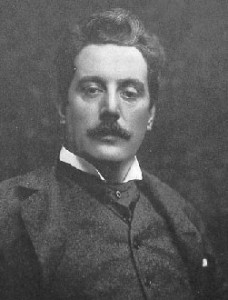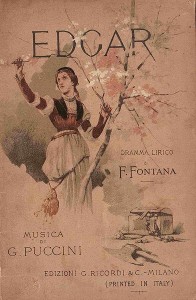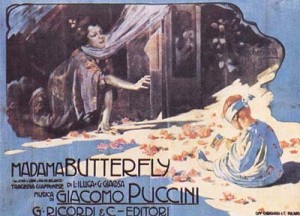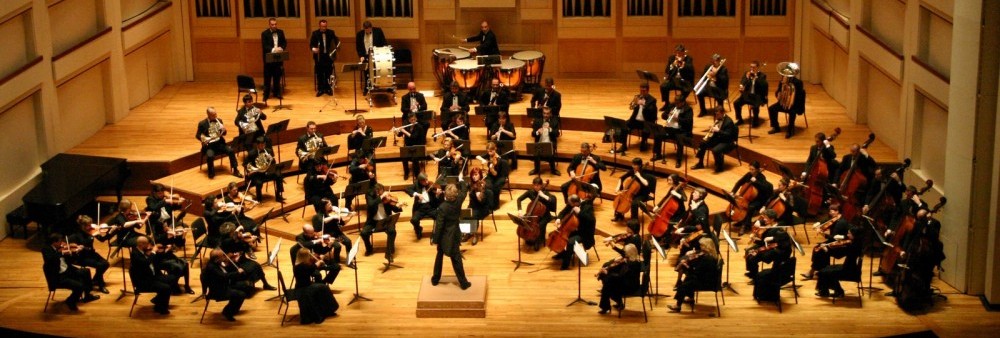Web Page By: Jack Setnicar
Created on April of 2014
Early Life

- Composer en:Giacomo Puccini in a studio photograph
by NewYork1956, used under CC0
Giacomo Puccini was born on December 22, 1858 in Lucca, Italy. His family had grand influences in music for generations prior to his birth. His father, Domenico Puccini, was also very successful publishing many piano sonatas and concertos and served as the cathedral organist in Lucca for many years. However, he tragically died when Giacomo was only five years old (Richards, 2011). Surprisingly, there is no evidence to suggest that Puccini had any interest in music early on in his life and it was not until he was 14 when he became a chairboy and played the organ at San Martino,that his musical talent began to manifest itself. He began writing small compositions by the time he reached 17 years of age, but it was ultimately the breathtaking performance of Giuessepe Verdi’s Aida in Milan that solidified his career choice to opera (Garret, 2010).
Early Career

- Cover of the libretto of Giacomo Puccini’s Edgar by Giovanni Zuccarelli
by Al Pereira, used under CC0
Giacomo enrolled himself at the Milan Conservatory in 1880 where he studied with a very renowned violinist and composer in Antonio Bazzini and Amilcare Ponchielli, who composed the opera La gioconda. It was in this very same year that Puccini produced his first very own religious work, Messa. Unfortunately, he did not enjoy unbridled success with his first few operas. He lost a contest in 1884 with his first opera, Le Villi. His second, Edgar, was a disappointment and was not well received, which he largely attributed to his poor librettos (Cahill, 2012).
Rise to Fame
Once Puccini found librettists that he found more suitable, he composed his third opera, Manon Lescautin in 1893. Interestingly, the plot was largely based off a similar story in the novel Manon Lescaut, published over one hundred fifty years earlier. Its protagonist is a young beautiful woman who eventually abandons her loved one to live a life of affluence and luxury. At the conclusion of the novel, she begins to regret the path she has chosen for her life, lamenting that she rejected her one true love. Puccini’s opera is rather revolutionary in that he has a sympathetic perspective for a woman who sacrificed her relationship in order to live the life that she wanted. It was viewed as a masterpiece by fans and music critics alike. This work is what finally opened the door for further wealth and prestige for Giacomo Puccini (Abbot, 2009).
Revolutionary Accomplishments
In Manon Lescaut, it seemed that Puccini had set a precedent to include a combination of dramatic romanticism and real controversial themes, such as feminism violence. In fact, many analysts debate whether his work pertains to the romantic or post-romantic musical era, specifically verismo. Verismo refers to a revolutionary style of music that originated in Italy in the 1890s that depicts realistic and sometimes violent perceptions of day to day life, primarily focusing on the lower classes. His next three operas are certainly his most widely known and prestigious works and they certainly utilize elements of verismo as well (Ferdinand, 2011).
The first of these three, La Boheme (1896), may be the most loosely based off the principles of verismo, but it is important to mention nonetheless, because the story is centered around four poverty-stricken artists that dwell in Paris. The poet, Rodolfo, meets an equally poor girl who does embroidery for a living and they fall in love. The fact that their lives are romanticized leads some analysts to believe that this play does not give justice to the life of a real lower class contemporary and therefore cannot fully consider La Boheme a play of the verismo genre. His second most famous work, Tosca that he composed in 1900 is more veristic depicting a political prisoner, an artist, and a vocalist that were hoodwinked by the chief of police (Ferdinand, 2011).

- Poster for Madama Butterfly
by Adolfo Hohenstein , used under CC0
Puccini’s Madama Butterfly (1904) is one of the most highly regarded true veristic operas in history. It is set in the real contemporary world, centered around an innocent female Japanese protagonist who is abused and betrayed by her American husband and who is eventually compelled to commit suicide. Perhaps, this is more regarded as true verismo than the other two, because it more truly depicts the hardships of the characters and because the young heroine’s life ends so tragically (Napoli, 2013).
